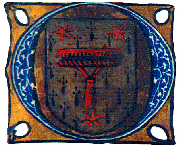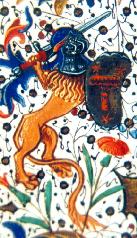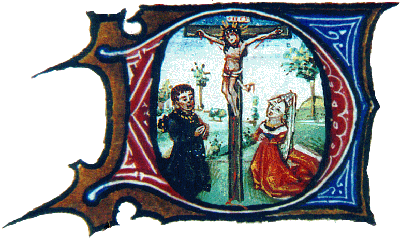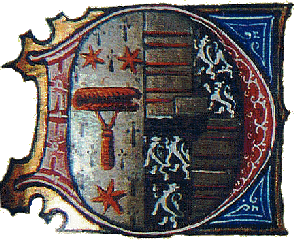The Marriage of Jacob and Phillippa
by Susannah Pendery and Jeff Lawson

Often, as books travel through the ages, the names and histories of the owners are lost to time. Although this is especially true in today's throwaway society, it also applies to beautiful and valuable books from ages long past. For example, one fifteenth century illuminated manuscript came to Scripps College through the donation of Ben Kirby in the late 1940s. However, the manuscript was unresearched, and although in good condition, its beginnings were shrouded in mystery.
When two historians in the 1980's began to examine the book, they contacted scholars in the area who might be familiar with either the particular style of art contained within the Book of Hours or the words and symbols found in the marginalia. The manuscript obviously involved a woman of comparable importance with the book, as a portrait of her is found on the opening illumination. They contacted Prof. Dr. K.G. Van Acker, the former Head Librarian of Centrale Bibliotheek der Rijksuniversiteit Gent, who confirmed that it was a Book of Hours written in Flemish as well as Latin. Through several correspondences, Consuelo Dutschke and Richard Rouse described the coat-of-arms found in the manuscript and Dr. Van Acker systematically narrowed the field until he had the shields positively identified as belonging to the Donche and Utenhove lines. This great accomplishment was only possible because of the existence of hundreds of thick volumes that document the lineage of some of the more important families of the time period. Additionally, council manuscripts, which are basically collections of Minutes from meetings of nobility, were especially useful in searching for clues about the Donches and the Utenhoves.

|
Kirby 1 was commissioned by Jacob (Jacques) Donche I (whose coat-of-arms is shown to the left), who lived from around 1432 to July 30, 1492 (Dutschke and Rouse 88). In 1460, he was appointed master of the waters and marshes of Flanders by the duke of Burgandy while in service of Margaret of York, the third wife of Duke Charles the Bold of Burgandy, and sister of the King of England, as master of her bookkeeping chamber (Van Acker 2). Later, in 1463, he became Councilor Commissary in the Council of Flanders. During the span of his life, he additionally served as the counsel of the Duke of Bourgogne. He advised Philip the Good as well as his son Charles the Bold (Dutschke and Rouse 88). Donche was very young, 19 or 20 years old, when the Ghent magistrates removed him from his duties as secretary of the "scepenen van ghedeele" of the city, November 1451 (Van Acker 5). However, his monetary standing in society matched his high political standing, putting him among the elite. In 1451, Donche married Maria Boudens, of who little else is known, other than she was the sister of Pieter (Pierre) Boudens. They lived together until Maria died on February 26, 1473 (Van Acker 3). |

|
|
After Maria Boudens' death, Phillippa Utenhove became his second wife when they were married already in july 1473. It has been estimated that she was about 20 years old when she married Donche, making her nearly 20 years younger that he was. Marriages between people of such greatly differing ages were not that uncommon during that time, especially among upper class families. Donche commissioned a Book of Hours to be created, from which these pictures come, for her on the occasion of their marriage, which is constantly reflected in the illuminations. Phillippa survived Donche when he died in 1492. Before she died on September 23, 1541, she had remarried to Christoffel Barousse, who lived at the court of the duke of Bourgogne as maître d'hotel of the duchess Maria and then her son Philip (Filips de Schone) before he became hooghballiu of Dendermonde (Van Acker 5). Jacob Donche I was buried in the Our Lady's Church at Dendermonde. A tomb in the Augustine Church at Ghent, that he had prepared for himself and both of his wifes, was only used for his first wife. |
 |
It may be important to note that older historical compilations often refer to a Jacob II who was frequently confused with Jacob I by historians. On more than one occasion, it was believed that Jacob I was married only once, to Maria Boudens, and that Jacob II was married to Phillippa Utenhove, though Kirby 1 clearly resolves this false issue. It has subsequently been suggested that Jacob II was the son of Jacob I, although there is no definite evidence to support this other than the great similarity between their two coat-of-arms. In fact, the only visible difference between the coat-of-arms of Jacob II and that of Jacob I is the absence of the inverted figure that can be faintly seen in the background of Jacob I's shield. It is known that Jacob II was bailey of Dendermonde and one of his descendants, Katerina, became later the wife of Schepperus, Councilor in the privy Council of Charles the V in the 16th Century (Van Acker 3-4). In fact Jacob II and Jacob I are the same person.
The primary illustration of the union of Jacob I and Phillippa Utenhove is the picture which appears at the very top of this page. In it, we see Jacob on the left, with his coat-of-arms as his feet, while Phillippa kneels on the right with a hybrid coat-of-arms joining the Utenhove and Donche shields. The scroll leading from his mouth reads, "Fiat Iacobe da Iacob instar Unna", while hers says "Queso Phillippe queat Curia pace frui" (Dutschke and Rouse 88). This scene is clearly a depiction of their wedding ceremony, as evidenced by the prominence of the miniature as well as the books they are consulting and the vows they are making to each other.

|
In many of the historiated letters, such as this one, the patron and his wife appear with the saint or exemplary figure. They are seen once with Saint James, patron saint of Jacob, and once with Philip, patron saint of Phillippa. They appear on six folios together, including the one at the left and the one at the beginning of this page (Dutschke and Rouse 87). These are clearly representative figures; not every one is an actual portrait, as they are dressed exactly the same in each one; these illuminations may not even look like the patrons at all. |
|
The marriage can also be traced by the blending of the coats-of-arms. Jacob Donche's shield, shown at the top of this page both alone and also being wielded by the lion, consists of a currycomb gules between three mullets of six points gules; there is also a light ermine pattern in the background (Dutschke and Rouse 88; Valentine 71, 80). The Utenhove coat-of-arms is shown at Phillippa's feet. It is identified by its quarterly nature, quadrants one and four argent filled by three double bars gules and quadrants two and three sable holding three lions rampant argent. In the center is a smaller sable shield with an argent bar, a symbol of cadency (Dutschke and Rouse 88; Valentine 71, 88). What you see to the right is their coat-of-arms impaled; his coat-of-arms dexter, on the dominant side, while hers is sinister (Dutschke and Rouse 88). |

|
Although any history about their daily life has faded to obscurity with time, and they themselves could have easily succumbed to the passage of time, this manuscript keeps them and their beautiful story alive.
However, it should be added, that a contemporary relative, Pieter Donche (Antwerp, Belgium) has been researching the Donche genealogy for over 20 years now and discovered many details about his life. Such as the house where Jacob lived in Ghent and which still exists in its 15th century form, and the exact year of death of his first wife, and of his second marriage: 1473 and not 1479 as almost all of the historical compilations write. Already in 1521 the death date of his first wife was incorrectly copied from the tombstone, and this error lived on for over 460 years and was responsible for much confusion and the creation of a Jacob II in an attempt to resolve conflicting details.
Hence, the year of the creation of the manuscript also has to be lowered by six years, that is in or after 1473 instead of 1480. (as is still written in 1986 book of Dutsche and Rouse)